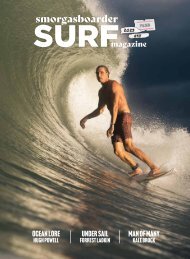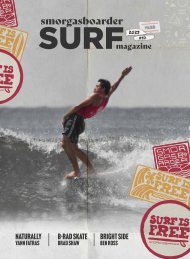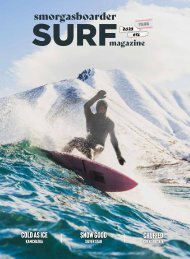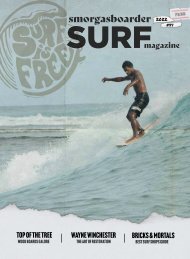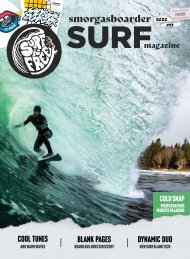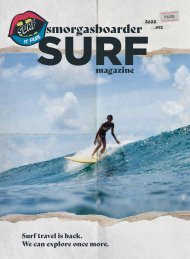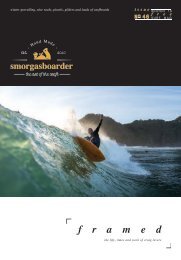SB_issue55_Digital
Create successful ePaper yourself
Turn your PDF publications into a flip-book with our unique Google optimized e-Paper software.
Jack explains the whole appeal of foiling<br />
to him, whether it be with a kite, wing,<br />
paddle or just the foilboard alone, is the<br />
fact that you can actually go somewhere<br />
without having to interrupt everyone<br />
else’s enjoyment out in the surf.<br />
“Yeah, the Wambos as I call them<br />
(wannabe wave Rambos) are the guys<br />
who will screw it up for everyone because<br />
they’re egomaniacs and they have to have<br />
an audience of people watching them in<br />
and out of crowded surf breaks when in<br />
actual fact they can go wherever all by<br />
themselves.”<br />
It is at this point I discussed with Jack his<br />
focus on what can be best described as<br />
‘assisted foiling’. The big issue with foiling<br />
being generating enough initial speed to<br />
engage the foil and get the board out of<br />
the water. Only so many people are skilled<br />
enough and light enough to be able to<br />
generate the speed required to get a<br />
small foil board up out of the water on foil,<br />
otherwise they have to rely on a foilboard<br />
the size of a SUP to give them the<br />
flotation they need to generate enough<br />
paddle power and speed to get on foil.<br />
With the smaller foilboards that is why you<br />
see the riders jumping up and down like<br />
jackhammers to try and engage the foil<br />
and get the board to lift. When you lean<br />
back, the wings tilt upright and in turn the<br />
board lifts up. You tilt forward and the<br />
foil levels and glides with the board out<br />
of the water. Pumping backwards and<br />
forwards, front foot, back foot, front foot<br />
again generates forward motion thanks<br />
to the mysterious law of physics falling<br />
under the category of kinetic energy, but<br />
it is bloody difficult and exhausting. It is<br />
here Jack picks up on our reference to the<br />
current crop of motorised foilboards we<br />
mentioned in this former article.<br />
“I’ve just reread your story on foiling<br />
and specifically in relation to motorised<br />
foilboards and you’re right, you’ve got<br />
a thing there which is 30kg (the battery<br />
alone weighs 11kg) and it’s designed<br />
to go full tilt at 40km an hour. So, if you<br />
ride one of those you’re just a petrol<br />
head. You might as well be on a jet ski or<br />
speedboat. It doesn’t enable you to feel<br />
and connect with the natural energy force<br />
I previously mentioned at all.<br />
“So, our focus has been on finding a<br />
means by which you can be assisted to<br />
get the board up and out of the water and<br />
on foil, and then, let Mother Nature do her<br />
thing.”<br />
Jack’s discovery of Foil Drive appears to<br />
be a solution for now.<br />
“These guys have been really clever<br />
about it. Instead of making a foilboard to<br />
go 40kms an hour, they’ve considered a<br />
way in which they can simply assist riders<br />
to get up on foil and over to the swell<br />
line where Mother Nature can then take<br />
over. This has seen the battery required<br />
significantly reduce in size from 11kgs<br />
down to 2kgs.<br />
<strong>SB</strong> / #55 / 82




